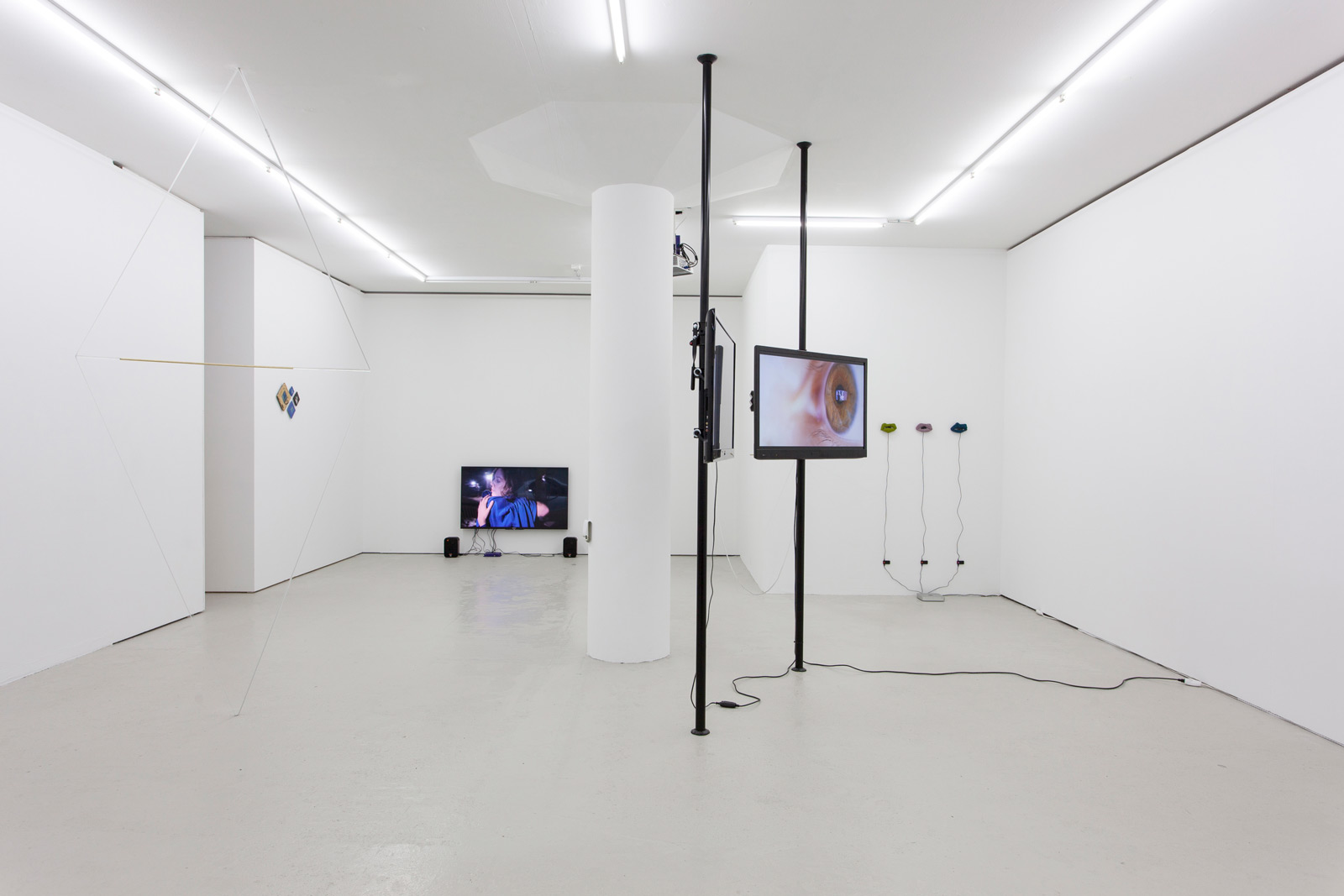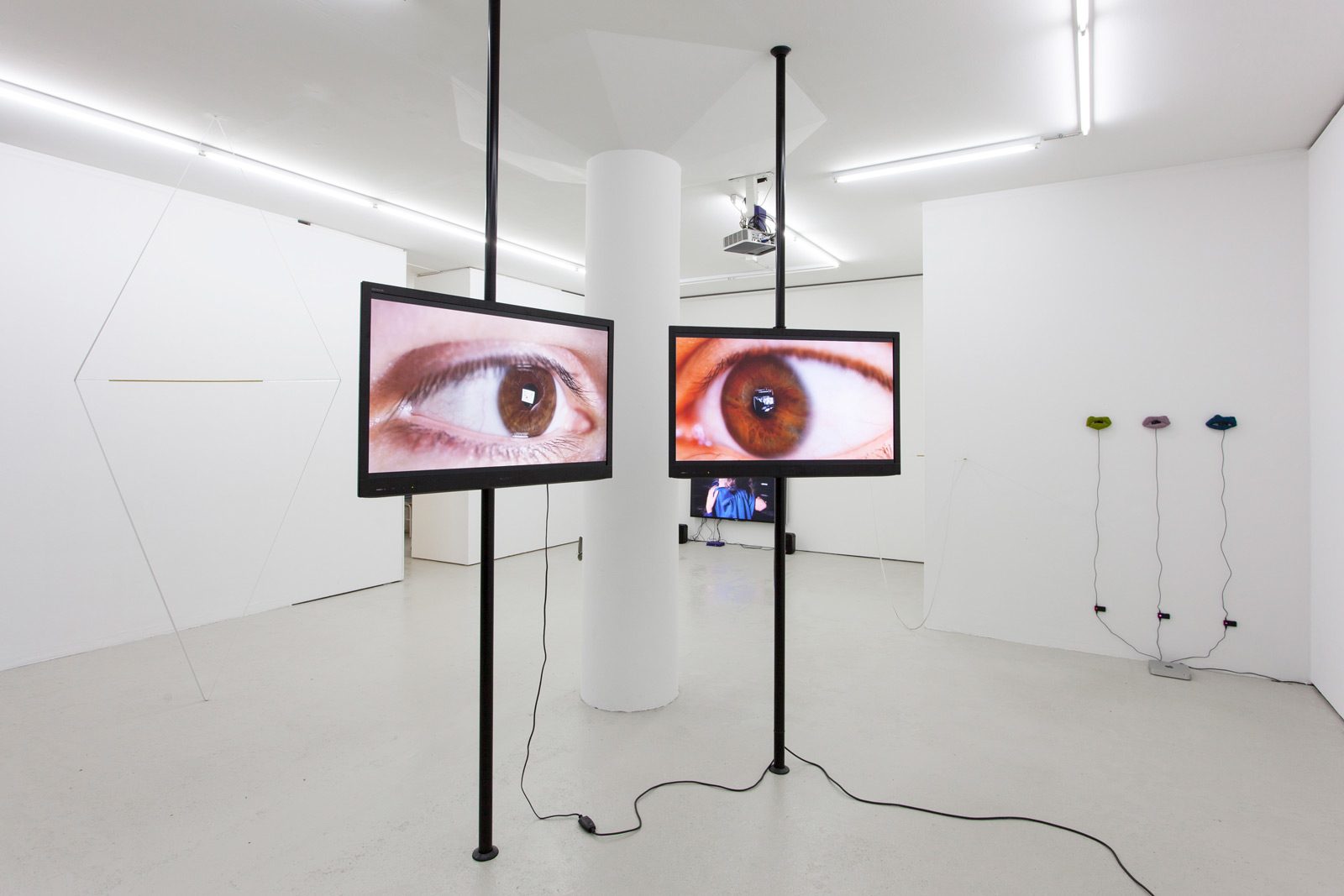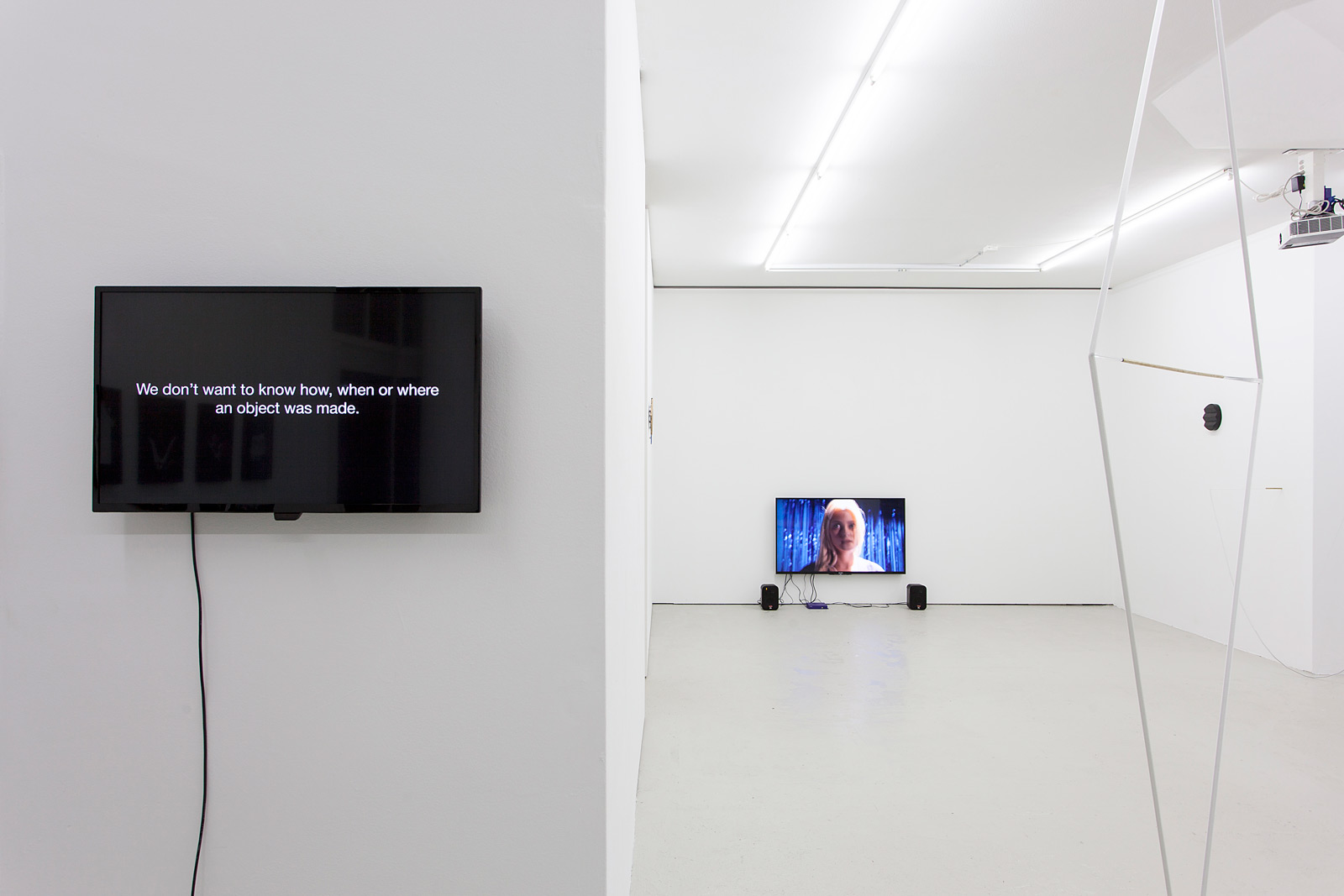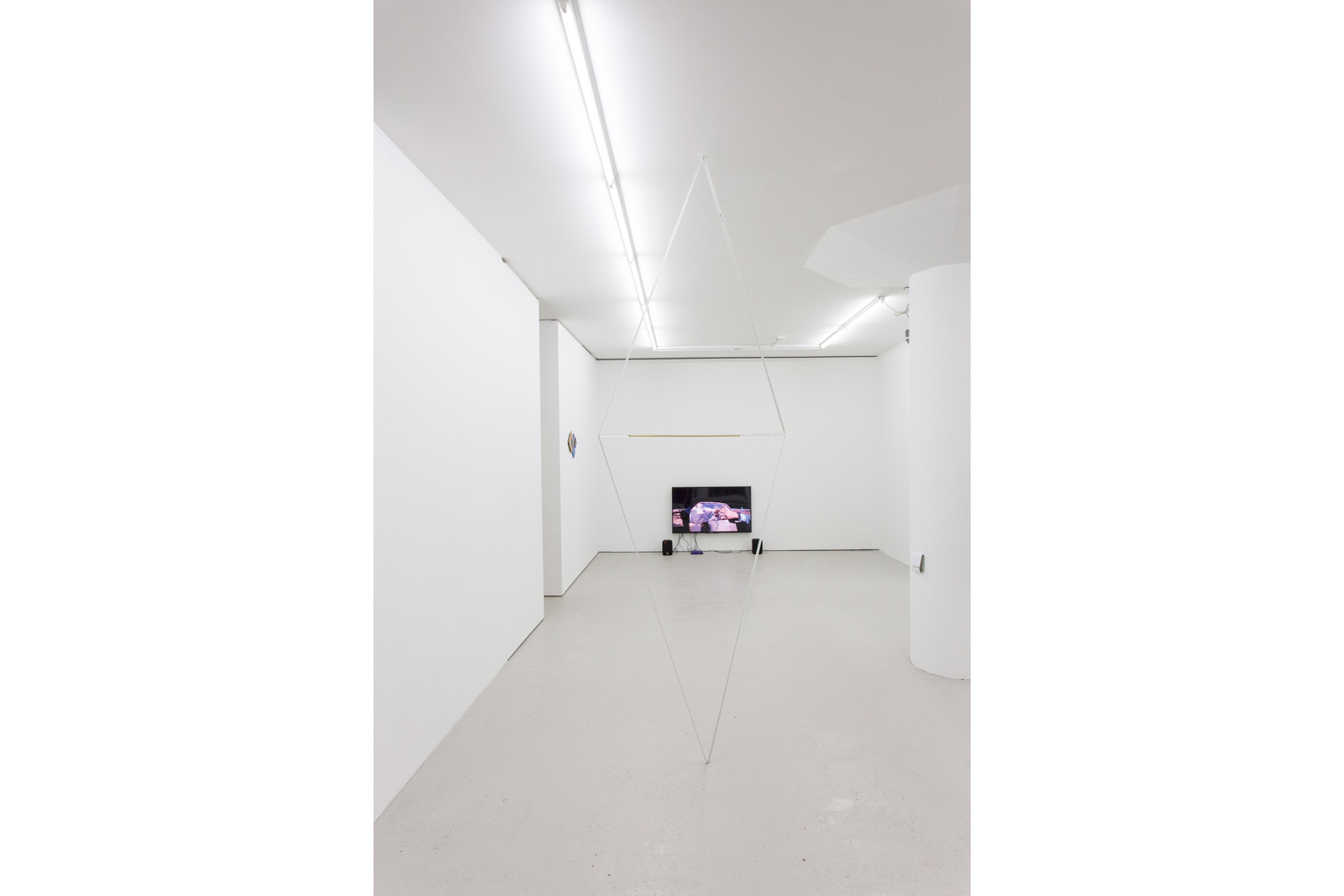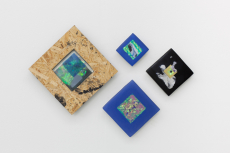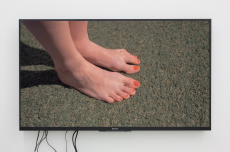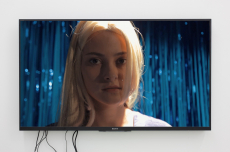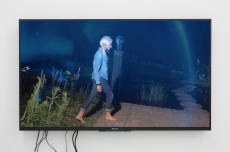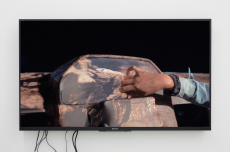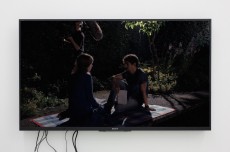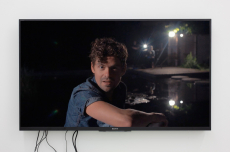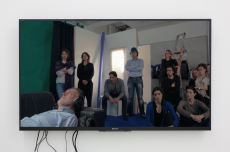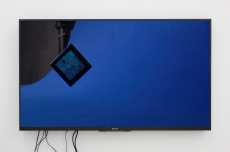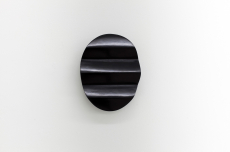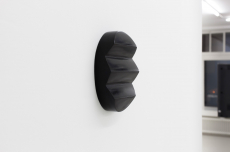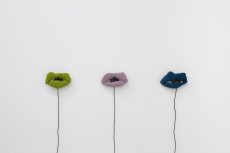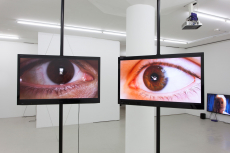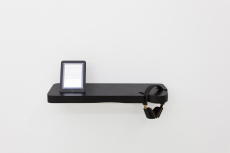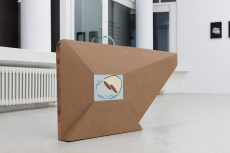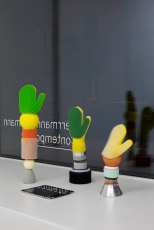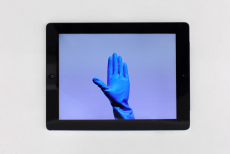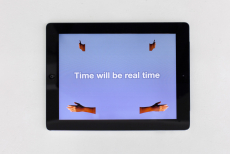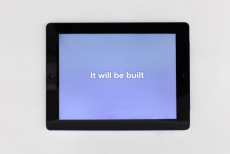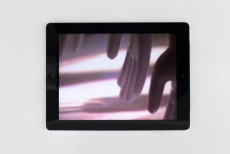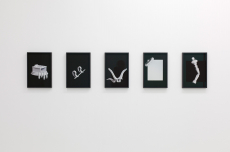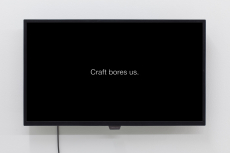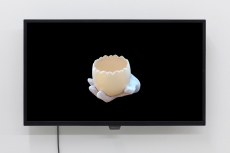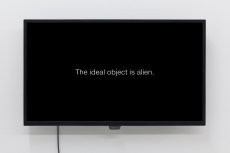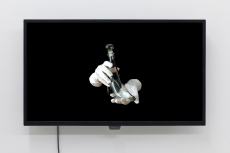Ghost Flowers
Riley Harmon, Marie von Heyl
Anna K. E. & Florian Meisenberg
Maude Léonard–Contant
Katharina Ludwig, Nora Mertes
curated by Lea Schleiffenbaum
12.11.2016–27.01.2017
Opening, Friday 11 November 2016
Riley Harmon (USA), Marie von Heyl (DE), Anna K. E. & Florian Meisenberg, Maude Léonard–Contant (CAN), Katharina Ludwig (DE), Nora Mertes (DE)
12.11.2016–27.01.2017
Opening, Friday 11 November 2016
Riley Harmon (USA), Marie von Heyl (DE), Anna K. E. & Florian Meisenberg, Maude Léonard–Contant (CAN), Katharina Ludwig (DE), Nora Mertes (DE)
What if you slept
And what if
In your sleep
You dreamed
And what if
In your dream
You went to heaven
And there plucked a strange and beautiful flower
And what if
When you awoke
You had the flower in your hand
Ah, what then?
— Samuel Taylor Coleridge, 18. Jahrhundert
The 21st century is often named the digital age. In the early 2000s we were already talking about the Post-Internet era. Everyone born after 1980 counts as a »digital native«. Digital natives seem to move effortlessly through spaces, overcoming national borders and social hierarchies. Yet are the phenomena generally credited to the digital revolution really new? Does Coleridge’s poem from the 18th Century not suggest instead that the creation of virtual worlds is a quality inherent to the human imagination? Do I not experience emotions stirred by digital media just as keenly as I do those aroused by direct, physical experience? The exhibition Ghost Flowers at Herrmann Germann Contemporary is an undertaking to break down boundaries between virtual and real, digital and analogue and to explore both levels as experiential spaces on equal terms. The Internet will, thus, become an additional public space that we can inhabit and design.
The role-play and alter egos which define life on the net are a key element of Riley Harmon’s artistic practice. According to Harmon, the unconscious knows no difference between reality and simulation. Here images, music and dreams are dealt with like real facts. In his film A Method for Blue Logic voices off read a collage of lines Harmon sourced from an online forum, leading through dream-like visual sequences. The voices discuss a conspiracy theory that the American government has employed an actress to be a national hero. A young blond woman sings a cover of the old jazz standard Georgia on my mind.
While Harmon is engaged with role-play and myths, Nora Mertes investigates our physical appreciation of spaces and images in her spatial interventions and installations. Her works are often like experimental arrangements in which the viewer plays an active part as an observing and observable body.
Marie von Heyl bridges the sensory experience of objects and their virtual adaption. »We have no empathy with objects that give away how they were made. [...] Craft bores us«, writes the artist in her Alien Object Manifesto. Her focus on surfaces is also apparent in The Occasional Table Series. Everyday objects covered with grey spray-paint look at a first glance as if they might be computer generated. Only on a closer look do small »flaws« or unevenness become visible. The misused use-objects exist somewhere on the cusp of being and seeming, between practicality and fetish.
The collaborative work Countdown Belladonna by Anna K. E. and Florian Meisenberg enables the viewer to look through the artist’s eyes in a true sense. Both videos show close-up footage of K. E. and Meisenberg’s eyes as they look at the displays of their smartphones. YouTube films, dance performances, music videos and film excerpts are seen in reflection on their pupils. The videos have a highly intimate and yet strange effect, as they bear witness to the nature of interpersonal relationships as well as the potential, though also the dangers, of the latest technical developments. The window to the soul here becomes an interface, while divergences such as man and machine, body and soul, are nullified.
A further leitmotif that runs through the exhibition is that of language. In her films, installations and objects Katharina Ludwig investigates the narrative structures that define our lives and that maintain power relationships. While objects serve her as sketches for the conceptual development of her installations, words find intuitive entry points in the works. Instead of explaining or describing, language here creates space for multi-layered interpretative approaches.
This vague and veiled method of dealing with language can also be found in Maude Léonard-Contant’s works. The texts in which the sculptor describes the material qualities and the forms and colours of not-yet-realised objects have a bewildering rather than clarifying effect. Here language becomes a virtual medium that forms new bodies. Léonard-Contant’s objects will be exhibited together with the related texts for the first time in the exhibition Ghost Flowers.
–––––
Riley Harmon, (b. 1987, Oklahoma US) often blurs the boundaries between fiction and reality in his work. His artistic practice originated in theatre and comes to fruition today in films, installations and performances. Harmon was grant holder at the Rijksakademie van beeldende kunsten in Amsterdam NL, from 2014–2016. His films have been shown in international museums and film festivals, including the International Documentary Film Festival in Amsterdam NL, the Schirn Kunsthalle in Frankfurt am Main DE, and the Foundation for Art and Creative Technology, Liverpool UK. A Method for Blue Logic will be shown at the Batard Festival, Brussels BE in November. Riley Harmon lives and works in Amsterdam NL.
Marie von Heyl, (b. 1981, Stuttgart DE) investigates objects as catalysts in which power structures, belief systems and emotional connections are fixed. The artist studied at the Weißensee Kunsthochschule in Berlin DE, and the Royal Academy in London UK. Her works were recently shown at the Kunstverein Wuppertal DE, in the LageEgal offsite in Vienna AT, at the New Release Gallery, New York US, and at the Kunstquartier Bethanien in Berlin DE. In 2013 Marie von Heyl was awarded the Deutsche Bank Award in Fine Art. She lives and works in Berlin DE.
Anna K. E., (b. 1986, Tiflis GE) brings together figurative and abstract elements in her drawings, films, sculptures and installations. A performative act often plays a pivotal role in these works. K. E. studied at the Kunstakademie Düsseldorf DE. Her works could be seen recently in Primary, Nottingham UK, at the Wrocław Contemporary Museum, Warsaw PL, at the E-Werk, Freiburg DE and in The Kitchen, New York US. In 2017 Anna K. E. is to realise a major mural work at the Queens Museum, New York US. The artist lives and works in New York US.
Maude Léonard-Contant, (b. 1979, Joliette CA) deals with the transformation of material and form in her texts, gouaches and sculptures. She studied at UQAM and Concordia University in Montreal CA. In the last year Léonard-Contant has exhibited at the Swiss Art Awards in Basel CH, at the Darling Foundry, Montreal CA, and the Alpineum Produzentgalerie, Luzern CH. She also won the Lucerne Cantonal Prize for Art. Maude Léonard-Conant lives and works in Basel CH.
Katharina Ludwig, (b. 1983, Starnberg DE) is interested in the various levels that human be-ing-in-the-world determines. She studied at the Design Academy in Eindhoven NL, and at Goldsmiths University in London UK. Her works were recently shown at the Museum Haus Hövener, Brilon DE, and at the Salon Dahlmann and Künstlerhaus Bethanien, both Berlin DE.
Florian Meisenberg, (b. 1980, Berlin DE) dissolves the limits of studio and exhibition space in his films and installations, as he also does in his paintings. Artist, curator and viewer are all described as digital users, so to speak. Meisenberg studied at the Kunstakademie in Düsseldorf DE. His works are shown regularly in international museum exhibitions, such as the Schirn Kunsthalle, Frankfurt DE, Murias Centeno, Lisbon PT, the Bundeskunsthalle, Bonn DE and the New Museum New York US, recently. In 2017 he shall have exhibitions at the Institute of Contemporary Art, Philadelphia US, and the Henie Onstad Kunstsenter, Oslo NO. Florian Meisenberg lives and works in New York US.
Nora Mertes, (b.1982, Herdecke DE) makes spatial interventions and installations that are akin to experimental arrangements in which physical and spatial boundaries are tested. Mertes studied at the Universität der Künste in Berlin DE, and the Alanus Hochschule Alfter, Bonn DE. Her works have recently been exhibited at the Ikob Museum für Zeitgenössische Kunst in Eupen BE, the MEWO Kunsthalle, Memmingen DE, the Skaftfell in Seydisfjördur IS, and Kilometer of Sculpture, Rakvere EE. Nora Mertes lives and works in Berlin DE.
Lea Schleiffenbaum, (b. 1985, Lucerne CH) studied at the University of Westminster, London UK, and at the Art Institute of Chicago US. She contributed to the preparation and practical realisation of numerous exhibition projects as curatorial assistant at the Schirn Kunsthalle, Frankfurt DE, and the Kunsthaus Dresden DE. Lea Schleiffenbaum is currently living in Berlin DE where she creates her own projects and exhibitions as an independent art historian.
The role-play and alter egos which define life on the net are a key element of Riley Harmon’s artistic practice. According to Harmon, the unconscious knows no difference between reality and simulation. Here images, music and dreams are dealt with like real facts. In his film A Method for Blue Logic voices off read a collage of lines Harmon sourced from an online forum, leading through dream-like visual sequences. The voices discuss a conspiracy theory that the American government has employed an actress to be a national hero. A young blond woman sings a cover of the old jazz standard Georgia on my mind.
While Harmon is engaged with role-play and myths, Nora Mertes investigates our physical appreciation of spaces and images in her spatial interventions and installations. Her works are often like experimental arrangements in which the viewer plays an active part as an observing and observable body.
Marie von Heyl bridges the sensory experience of objects and their virtual adaption. »We have no empathy with objects that give away how they were made. [...] Craft bores us«, writes the artist in her Alien Object Manifesto. Her focus on surfaces is also apparent in The Occasional Table Series. Everyday objects covered with grey spray-paint look at a first glance as if they might be computer generated. Only on a closer look do small »flaws« or unevenness become visible. The misused use-objects exist somewhere on the cusp of being and seeming, between practicality and fetish.
The collaborative work Countdown Belladonna by Anna K. E. and Florian Meisenberg enables the viewer to look through the artist’s eyes in a true sense. Both videos show close-up footage of K. E. and Meisenberg’s eyes as they look at the displays of their smartphones. YouTube films, dance performances, music videos and film excerpts are seen in reflection on their pupils. The videos have a highly intimate and yet strange effect, as they bear witness to the nature of interpersonal relationships as well as the potential, though also the dangers, of the latest technical developments. The window to the soul here becomes an interface, while divergences such as man and machine, body and soul, are nullified.
A further leitmotif that runs through the exhibition is that of language. In her films, installations and objects Katharina Ludwig investigates the narrative structures that define our lives and that maintain power relationships. While objects serve her as sketches for the conceptual development of her installations, words find intuitive entry points in the works. Instead of explaining or describing, language here creates space for multi-layered interpretative approaches.
This vague and veiled method of dealing with language can also be found in Maude Léonard-Contant’s works. The texts in which the sculptor describes the material qualities and the forms and colours of not-yet-realised objects have a bewildering rather than clarifying effect. Here language becomes a virtual medium that forms new bodies. Léonard-Contant’s objects will be exhibited together with the related texts for the first time in the exhibition Ghost Flowers.
–––––
Riley Harmon, (b. 1987, Oklahoma US) often blurs the boundaries between fiction and reality in his work. His artistic practice originated in theatre and comes to fruition today in films, installations and performances. Harmon was grant holder at the Rijksakademie van beeldende kunsten in Amsterdam NL, from 2014–2016. His films have been shown in international museums and film festivals, including the International Documentary Film Festival in Amsterdam NL, the Schirn Kunsthalle in Frankfurt am Main DE, and the Foundation for Art and Creative Technology, Liverpool UK. A Method for Blue Logic will be shown at the Batard Festival, Brussels BE in November. Riley Harmon lives and works in Amsterdam NL.
Marie von Heyl, (b. 1981, Stuttgart DE) investigates objects as catalysts in which power structures, belief systems and emotional connections are fixed. The artist studied at the Weißensee Kunsthochschule in Berlin DE, and the Royal Academy in London UK. Her works were recently shown at the Kunstverein Wuppertal DE, in the LageEgal offsite in Vienna AT, at the New Release Gallery, New York US, and at the Kunstquartier Bethanien in Berlin DE. In 2013 Marie von Heyl was awarded the Deutsche Bank Award in Fine Art. She lives and works in Berlin DE.
Anna K. E., (b. 1986, Tiflis GE) brings together figurative and abstract elements in her drawings, films, sculptures and installations. A performative act often plays a pivotal role in these works. K. E. studied at the Kunstakademie Düsseldorf DE. Her works could be seen recently in Primary, Nottingham UK, at the Wrocław Contemporary Museum, Warsaw PL, at the E-Werk, Freiburg DE and in The Kitchen, New York US. In 2017 Anna K. E. is to realise a major mural work at the Queens Museum, New York US. The artist lives and works in New York US.
Maude Léonard-Contant, (b. 1979, Joliette CA) deals with the transformation of material and form in her texts, gouaches and sculptures. She studied at UQAM and Concordia University in Montreal CA. In the last year Léonard-Contant has exhibited at the Swiss Art Awards in Basel CH, at the Darling Foundry, Montreal CA, and the Alpineum Produzentgalerie, Luzern CH. She also won the Lucerne Cantonal Prize for Art. Maude Léonard-Conant lives and works in Basel CH.
Katharina Ludwig, (b. 1983, Starnberg DE) is interested in the various levels that human be-ing-in-the-world determines. She studied at the Design Academy in Eindhoven NL, and at Goldsmiths University in London UK. Her works were recently shown at the Museum Haus Hövener, Brilon DE, and at the Salon Dahlmann and Künstlerhaus Bethanien, both Berlin DE.
Florian Meisenberg, (b. 1980, Berlin DE) dissolves the limits of studio and exhibition space in his films and installations, as he also does in his paintings. Artist, curator and viewer are all described as digital users, so to speak. Meisenberg studied at the Kunstakademie in Düsseldorf DE. His works are shown regularly in international museum exhibitions, such as the Schirn Kunsthalle, Frankfurt DE, Murias Centeno, Lisbon PT, the Bundeskunsthalle, Bonn DE and the New Museum New York US, recently. In 2017 he shall have exhibitions at the Institute of Contemporary Art, Philadelphia US, and the Henie Onstad Kunstsenter, Oslo NO. Florian Meisenberg lives and works in New York US.
Nora Mertes, (b.1982, Herdecke DE) makes spatial interventions and installations that are akin to experimental arrangements in which physical and spatial boundaries are tested. Mertes studied at the Universität der Künste in Berlin DE, and the Alanus Hochschule Alfter, Bonn DE. Her works have recently been exhibited at the Ikob Museum für Zeitgenössische Kunst in Eupen BE, the MEWO Kunsthalle, Memmingen DE, the Skaftfell in Seydisfjördur IS, and Kilometer of Sculpture, Rakvere EE. Nora Mertes lives and works in Berlin DE.
Lea Schleiffenbaum, (b. 1985, Lucerne CH) studied at the University of Westminster, London UK, and at the Art Institute of Chicago US. She contributed to the preparation and practical realisation of numerous exhibition projects as curatorial assistant at the Schirn Kunsthalle, Frankfurt DE, and the Kunsthaus Dresden DE. Lea Schleiffenbaum is currently living in Berlin DE where she creates her own projects and exhibitions as an independent art historian.
Das 21. Jahrhundert wird oft als Zeitalter des Digitalen tituliert. Bereits in den frühen 2000er-Jahren begann man von der Post-Internet Ära zu sprechen. Alle diejenigen, die nach 1980 geboren wurden gelten als »Digital Natives«. Sie bewegen sich scheinbar mühelos durch Räume, überwinden nationale Grenzen und soziale Hierarchien. Doch sind die Phänomene, die gemeinhin der digitalen Revolution angerechnet werden, tatsächlich neu? Suggeriert das Gedicht Coleridges aus dem 18. Jahrhundert nicht vielmehr, dass das Schaffen von virtuellen Welten eine der menschlichen Fantasie inhärente Eigenschaft ist? Erlebe ich Emotionen, die durch digitale Medien ausgelöst werden, nicht genau so real wie solche, die durch eine direkte physische Erfahrung hervorgerufen werden? Die Ausstellung Ghost Flowers bei Herrmann Germann Contemporary unternimmt den Versuch, die Grenzen zwischen virtuell und reell, zwischen digital und analog zu durchbrechen und beide Ebenen als gleichgestellte Erfahrungsräume zu erkunden. Das Internet wird hiernach zu einem weiteren öffentlichen Raum, den wir bewohnen und gestalten können.
Die Rollenspiele und Alteregos, welche das Leben im Netz bestimmen, bilden einen festen Bestandteil in Riley Harmons künstlerischer Praxis. Laut Harmon kennt das Unterbewusstsein keinen Unterschied zwischen Wirklichkeit und Simulation. Bilder, Musik und Träume werden hier gleich behandelt wie reale Fakten. In seinem Film A Method for Blue Logic führen Stimmen aus dem Off mit einer Collage von Sätzen, die Harmon von einem online Forum gesourced hat, durch traumartige Sequenzen. Die Beiträge diskutieren eine Verschwörungstheorie laut der die Amerikanische Regierung eine Schauspielerin als Nationale Heldin angeheuert hat. Eine junge, blonde Frau singt das Cover des alten Jazz-Standards Georgia on my mind.
Während Harmon sich mit Rollenspielen und Mythen beschäftigt, untersucht Nora Mertes in ihren Rauminterventionen und Installationen unsere physische Wahrnehmung von Räumen und Bildern. Ihre Arbeiten gleichen oft Versuchsanordnungen, bei denen der Betrachter als wahrnehmender und wahrzunehmender Körper aktiv Anteil nimmt.
Marie von Heyl schlägt die Brücke zwischen dem sensorischen Erleben von Objekten und deren virtuelle Adaption. »We have no empathy with objects that give away how they were made. [...] Craft bores us«, schreibt die Künstlerin in ihrem Alien Object Manifesto. Diese Fokussierung auf Oberflächen wird auch in ihrer Serie The Occasional Table Series deutlich. Die mit grauer Sprühfarbe bemalten Alltagsgegenstände wirken auf den ersten Blick Computer generiert. Erst bei genauerem Hinsehen werden kleine »Fehler« oder Unebenheiten auf der Oberfläche sichtbar. Die zweckentfremdeten Nutzobjekte bewegen sich irgendwo auf der Schnittstelle zwischen Schein und Sein, zwischen Nutzobjekt und Fetisch.
Die Gemeinschaftsarbeit Countdown Belladonna von Anna K. E. und Florian Meisenberg erlaubt dem Betrachter im wahrsten Sinne durch die Augen der Künstler zu blicken. Die beiden Videos zeigen Nahaufnahmen der Augen von K. E. und Meisenberg, während diese auf das Display ihrer Smartphones schauen. In der Reflexion ihrer Pupillen spiegeln sich YouTube Filme, Tanzperformances, Musikvideos und Ausschnitte von Filmen. Die Videos wirken zutiefst intim und zugleich befremdlich, zeugen sie doch von der Natur zwischenmenschlicher Beziehungen, sowie dem Potential, aber auch der Gefahr jüngster technischer Entwicklungen. Das Fenster zur Seele wird hier zum Interface, Divergenzen wie Mensch und Maschine, Körper und Seele werden aufgehoben.
Ein weiteres Thema, welches sich wie ein roter Faden durch die Ausstellung zieht, ist Sprache. In ihren Filmen, Installationen und Objekten untersucht Katharina Ludwig die narrativen Strukturen, die unsere Leben bestimmen und Machtverhältnisse aufrecht erhalten. Während Objekte ihr als Skizzen für die konzeptuelle Ausarbeitung ihrer Installationen dienen, finden Worte intuitiv Einzug in die Arbeiten. Statt zu erklären oder beschreiben, schafft Sprache hier Raum für vielschichtige Interpretationsansätze.
Diesen unkonkreten, verschleiernden Umgang mit Sprache finden wir auch in den Arbeiten von Maude Léonard-Contant. Ihre Texte, in denen die Bildhauerin die materielle Beschaffenheit, sowie die Formen und Farben von noch nicht umgesetzten Objekten beschreibt, wirken eher verwirrend als aufklärend. Sprache wird hier zu einem virtuellen Medium, das neue Körper formt. In der Ausstellung Ghost Flowers werden Léonard-Contants Objekte zum ersten Mal gemeinsam mit den ihnen zugehörigen Texten ausgestellt.
–––––
Riley Harmon, *1987, Oklahoma US, verwischt in seinen Arbeiten oft die Grenzen zwischen Fiktion und Realität. Seine künstlerische Praxis nahm im Theater ihren Ursprung und findet heute in Filmen, Installationen und Performances Ausdruck. Von 2014 bis 2016 war Harmon Stipendiat an der Rijksakademie van beeldende kunsten in Amsterdam NL. Seine Filme wurden in Internationalen Museen und Filmfestivals gezeigt, darunter das International Documentary Film Festival in Amsterdam NL, die Schirn Kunsthalle in Frankfurt am Main DE und in der Foundation for Art and Creative Technology in Liverpool UK. A Method for Blue Logic wird im November auf dem Batard Festival in Brüssel BE gezeigt. Riley Harmon lebt und arbeitet in Amsterdam NL.
Marie von Heyl, *1981 in Stuttgart DE, untersucht Objekte als Katalysatoren, in denen Machtstrukturen, Glaubenssysteme und emotionale Bindung verankert sind. Die Künstlerin hat an der Weißensee Kunsthochschule in Berlin DE und an der Royal Academy in London UK studiert. Zuletzt waren ihre Arbeiten im Kunstverein Wuppertal DE, in der LageEgal Off Site in Wien AT, in der New Release Gallery in New York US und im Kunstquartier Bethanien in Berlin DE zu sehen. 2013 hat Marie von Heyl den Deutsche Bank Award in Fine Art erhalten. Sie lebt und arbeitet in Berlin DE.
Anna K. E., *1986 in Tiflis GE, vereint in ihren Zeichnungen, Filmen, Skulpturen und Installationen figurative und abstrakte Elemente. Oft spielt der performative Akt dabei eine ausschlaggebende Rolle. K. E. hat in der Kunstakademie Düsseldorf DE studiert. Ihre Arbeiten waren zuletzt im Primary in Nottingham UK, im Wrocław Contemporary Museum in Warschau PL, im E-Werk in Freiburg DE und in The Kitchen in New York US zu sehen. 2017 wird Anna K. E. eine grosse Wandarbeit im Queens Museum in New York US umsetzen. Die Künstlerin lebt und arbeitet in New York US.
Maude Léonard-Contant, *1979 in Joliette CA, setzt sich in ihren Texten, Gouachen und Skulpturen mit der Transformation von Material und Form auseinander. Sie hat an der UQAM und an der Concordia University in Montreal CA studiert. Im letzten Jahr stellte Léonard-Contant bei den Swiss Art Awards in Basel CH, in der Darling Foundry in Montreal CA und in der Alpineum Produzentgalerie in Luzern CH aus. Ausserdem gewann sie den Luzerner Kantonspreis für Kunst. Maude Léonard-Contant lebt und arbeitet in Basel CH.
Katharina Ludwig, *1983 in Starnberg DE, interessiert sich für die unterschiedlichen Ebenen, die das menschliche In-der-Welt-sein bestimmen. Sie studierte an der Design Academy in Eindhoven NL und an der Goldsmiths University in London UK. Ihre Werke wurden zuletzt im Museum Haus Hövener in Brilon DE, im Salon Dahlmann und im Künstlerhaus Bethanien, beides in Berlin DE, ausgestellt. Katharina Ludwig lebt und arbeitet in Berlin DE.
Florian Meisenberg, *1980 in Berlin DE, unterbricht in seinen Filmen und Installationen, aber auch in seinen Gemälden die Grenze zwischen Atelier und Ausstellungsraum. Künstler, Kurator und Betrachter werden hier gleichsam zu digitalen Usern erklärt. Meisenberg hat an der Kunstakademie in Düsseldorf DE studiert. Seine Arbeiten werden regelmässig in internationalen Museumsausstellungen gezeigt, so zuletzt in der Schirn Kunsthalle in Frankfurt DE, im Murias Centeno in Lissabon PT, in der Bundeskunsthalle in Bonn DE und im New Museum in New York US. 2017 folgen Ausstellungen im Institute of Contemporary Art in Philadelphia US und im Henie Onstad Kunstsenter in Oslo NO. Florian Meisenberg lebt und arbeitet in New York US.
Nora Mertes, *1982 in Herdecke DE, Rauminterventionen und Installationen gleichen Versuchsanordnungen, bei denen physische und räumliche Grenzen auf die Probe gestellt werden. Mertes hat an der Universität der Künste in Berlin DE und an der Alanus Hochschule Alfter in Bonn DE studiert. Ihre Arbeiten wurden zuletzt im Ikob Museum für Zeitgenössische Kunst in Eupen BE, in der MEWO Kunsthalle in Memmingen DE, im Skaftfell in Seydisfjördur IS und im Kilometer of Sculpture in Rakvere EE ausgestellt. Nora Mertes lebt und arbeitet in Berlin DE.
Lea Schleiffenbaum, *1985, Luzern CH, studierte an der University of Westminster in London UK und am Art Institute of Chicago US. Als kuratorische Assistentin der Schirn Kunsthalle in Frankfurt DE und dem Kunsthaus Dresden DE hat sie zu der inhaltlichen Aufbereitung und der praktischen Umsetzung zahlreicher Ausstellungsprojekten beigetragen.
Zur Zeit lebt Lea Schleiffenbaum als Kunsthistorikerin in Berlin DE und realisiert eigene Projekte und Ausstellungen.
Die Rollenspiele und Alteregos, welche das Leben im Netz bestimmen, bilden einen festen Bestandteil in Riley Harmons künstlerischer Praxis. Laut Harmon kennt das Unterbewusstsein keinen Unterschied zwischen Wirklichkeit und Simulation. Bilder, Musik und Träume werden hier gleich behandelt wie reale Fakten. In seinem Film A Method for Blue Logic führen Stimmen aus dem Off mit einer Collage von Sätzen, die Harmon von einem online Forum gesourced hat, durch traumartige Sequenzen. Die Beiträge diskutieren eine Verschwörungstheorie laut der die Amerikanische Regierung eine Schauspielerin als Nationale Heldin angeheuert hat. Eine junge, blonde Frau singt das Cover des alten Jazz-Standards Georgia on my mind.
Während Harmon sich mit Rollenspielen und Mythen beschäftigt, untersucht Nora Mertes in ihren Rauminterventionen und Installationen unsere physische Wahrnehmung von Räumen und Bildern. Ihre Arbeiten gleichen oft Versuchsanordnungen, bei denen der Betrachter als wahrnehmender und wahrzunehmender Körper aktiv Anteil nimmt.
Marie von Heyl schlägt die Brücke zwischen dem sensorischen Erleben von Objekten und deren virtuelle Adaption. »We have no empathy with objects that give away how they were made. [...] Craft bores us«, schreibt die Künstlerin in ihrem Alien Object Manifesto. Diese Fokussierung auf Oberflächen wird auch in ihrer Serie The Occasional Table Series deutlich. Die mit grauer Sprühfarbe bemalten Alltagsgegenstände wirken auf den ersten Blick Computer generiert. Erst bei genauerem Hinsehen werden kleine »Fehler« oder Unebenheiten auf der Oberfläche sichtbar. Die zweckentfremdeten Nutzobjekte bewegen sich irgendwo auf der Schnittstelle zwischen Schein und Sein, zwischen Nutzobjekt und Fetisch.
Die Gemeinschaftsarbeit Countdown Belladonna von Anna K. E. und Florian Meisenberg erlaubt dem Betrachter im wahrsten Sinne durch die Augen der Künstler zu blicken. Die beiden Videos zeigen Nahaufnahmen der Augen von K. E. und Meisenberg, während diese auf das Display ihrer Smartphones schauen. In der Reflexion ihrer Pupillen spiegeln sich YouTube Filme, Tanzperformances, Musikvideos und Ausschnitte von Filmen. Die Videos wirken zutiefst intim und zugleich befremdlich, zeugen sie doch von der Natur zwischenmenschlicher Beziehungen, sowie dem Potential, aber auch der Gefahr jüngster technischer Entwicklungen. Das Fenster zur Seele wird hier zum Interface, Divergenzen wie Mensch und Maschine, Körper und Seele werden aufgehoben.
Ein weiteres Thema, welches sich wie ein roter Faden durch die Ausstellung zieht, ist Sprache. In ihren Filmen, Installationen und Objekten untersucht Katharina Ludwig die narrativen Strukturen, die unsere Leben bestimmen und Machtverhältnisse aufrecht erhalten. Während Objekte ihr als Skizzen für die konzeptuelle Ausarbeitung ihrer Installationen dienen, finden Worte intuitiv Einzug in die Arbeiten. Statt zu erklären oder beschreiben, schafft Sprache hier Raum für vielschichtige Interpretationsansätze.
Diesen unkonkreten, verschleiernden Umgang mit Sprache finden wir auch in den Arbeiten von Maude Léonard-Contant. Ihre Texte, in denen die Bildhauerin die materielle Beschaffenheit, sowie die Formen und Farben von noch nicht umgesetzten Objekten beschreibt, wirken eher verwirrend als aufklärend. Sprache wird hier zu einem virtuellen Medium, das neue Körper formt. In der Ausstellung Ghost Flowers werden Léonard-Contants Objekte zum ersten Mal gemeinsam mit den ihnen zugehörigen Texten ausgestellt.
–––––
Riley Harmon, *1987, Oklahoma US, verwischt in seinen Arbeiten oft die Grenzen zwischen Fiktion und Realität. Seine künstlerische Praxis nahm im Theater ihren Ursprung und findet heute in Filmen, Installationen und Performances Ausdruck. Von 2014 bis 2016 war Harmon Stipendiat an der Rijksakademie van beeldende kunsten in Amsterdam NL. Seine Filme wurden in Internationalen Museen und Filmfestivals gezeigt, darunter das International Documentary Film Festival in Amsterdam NL, die Schirn Kunsthalle in Frankfurt am Main DE und in der Foundation for Art and Creative Technology in Liverpool UK. A Method for Blue Logic wird im November auf dem Batard Festival in Brüssel BE gezeigt. Riley Harmon lebt und arbeitet in Amsterdam NL.
Marie von Heyl, *1981 in Stuttgart DE, untersucht Objekte als Katalysatoren, in denen Machtstrukturen, Glaubenssysteme und emotionale Bindung verankert sind. Die Künstlerin hat an der Weißensee Kunsthochschule in Berlin DE und an der Royal Academy in London UK studiert. Zuletzt waren ihre Arbeiten im Kunstverein Wuppertal DE, in der LageEgal Off Site in Wien AT, in der New Release Gallery in New York US und im Kunstquartier Bethanien in Berlin DE zu sehen. 2013 hat Marie von Heyl den Deutsche Bank Award in Fine Art erhalten. Sie lebt und arbeitet in Berlin DE.
Anna K. E., *1986 in Tiflis GE, vereint in ihren Zeichnungen, Filmen, Skulpturen und Installationen figurative und abstrakte Elemente. Oft spielt der performative Akt dabei eine ausschlaggebende Rolle. K. E. hat in der Kunstakademie Düsseldorf DE studiert. Ihre Arbeiten waren zuletzt im Primary in Nottingham UK, im Wrocław Contemporary Museum in Warschau PL, im E-Werk in Freiburg DE und in The Kitchen in New York US zu sehen. 2017 wird Anna K. E. eine grosse Wandarbeit im Queens Museum in New York US umsetzen. Die Künstlerin lebt und arbeitet in New York US.
Maude Léonard-Contant, *1979 in Joliette CA, setzt sich in ihren Texten, Gouachen und Skulpturen mit der Transformation von Material und Form auseinander. Sie hat an der UQAM und an der Concordia University in Montreal CA studiert. Im letzten Jahr stellte Léonard-Contant bei den Swiss Art Awards in Basel CH, in der Darling Foundry in Montreal CA und in der Alpineum Produzentgalerie in Luzern CH aus. Ausserdem gewann sie den Luzerner Kantonspreis für Kunst. Maude Léonard-Contant lebt und arbeitet in Basel CH.
Katharina Ludwig, *1983 in Starnberg DE, interessiert sich für die unterschiedlichen Ebenen, die das menschliche In-der-Welt-sein bestimmen. Sie studierte an der Design Academy in Eindhoven NL und an der Goldsmiths University in London UK. Ihre Werke wurden zuletzt im Museum Haus Hövener in Brilon DE, im Salon Dahlmann und im Künstlerhaus Bethanien, beides in Berlin DE, ausgestellt. Katharina Ludwig lebt und arbeitet in Berlin DE.
Florian Meisenberg, *1980 in Berlin DE, unterbricht in seinen Filmen und Installationen, aber auch in seinen Gemälden die Grenze zwischen Atelier und Ausstellungsraum. Künstler, Kurator und Betrachter werden hier gleichsam zu digitalen Usern erklärt. Meisenberg hat an der Kunstakademie in Düsseldorf DE studiert. Seine Arbeiten werden regelmässig in internationalen Museumsausstellungen gezeigt, so zuletzt in der Schirn Kunsthalle in Frankfurt DE, im Murias Centeno in Lissabon PT, in der Bundeskunsthalle in Bonn DE und im New Museum in New York US. 2017 folgen Ausstellungen im Institute of Contemporary Art in Philadelphia US und im Henie Onstad Kunstsenter in Oslo NO. Florian Meisenberg lebt und arbeitet in New York US.
Nora Mertes, *1982 in Herdecke DE, Rauminterventionen und Installationen gleichen Versuchsanordnungen, bei denen physische und räumliche Grenzen auf die Probe gestellt werden. Mertes hat an der Universität der Künste in Berlin DE und an der Alanus Hochschule Alfter in Bonn DE studiert. Ihre Arbeiten wurden zuletzt im Ikob Museum für Zeitgenössische Kunst in Eupen BE, in der MEWO Kunsthalle in Memmingen DE, im Skaftfell in Seydisfjördur IS und im Kilometer of Sculpture in Rakvere EE ausgestellt. Nora Mertes lebt und arbeitet in Berlin DE.
Lea Schleiffenbaum, *1985, Luzern CH, studierte an der University of Westminster in London UK und am Art Institute of Chicago US. Als kuratorische Assistentin der Schirn Kunsthalle in Frankfurt DE und dem Kunsthaus Dresden DE hat sie zu der inhaltlichen Aufbereitung und der praktischen Umsetzung zahlreicher Ausstellungsprojekten beigetragen.
Zur Zeit lebt Lea Schleiffenbaum als Kunsthistorikerin in Berlin DE und realisiert eigene Projekte und Ausstellungen.

